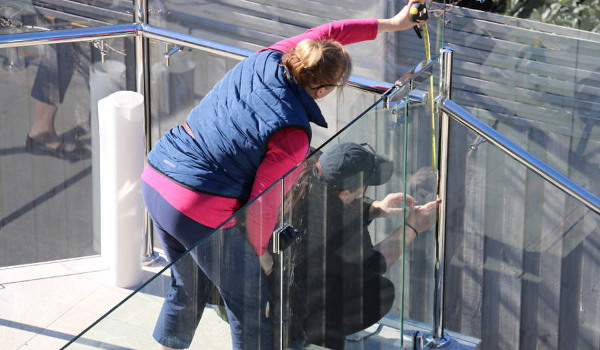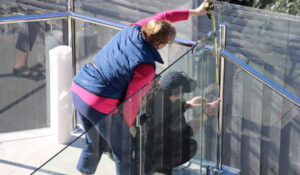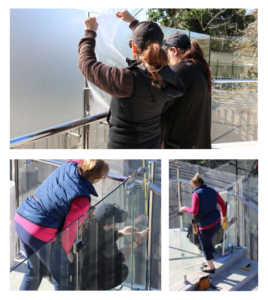How to Choose the Right Privacy Film for Your Windows
Privacy is a crucial aspect of our lives, and maintaining it within our living spaces is essential. One effective way to enhance privacy in our homes, offices, or commercial spaces is by installing privacy film on windows. Privacy films come in a variety of options, each offering different levels of privacy, light transmission, and aesthetic appeal. In this article, we will discuss the factors to consider when choosing the right privacy film for your windows, the different types available, application areas, installation tips, maintenance guidelines, cost considerations, and more.
Privacy film serves as a practical and stylish solution to maintain privacy while allowing natural light to enter a space. It is commonly used in residential buildings, offices, commercial spaces, and various other settings. When selecting the right privacy film for your windows, several factors should be taken into account to ensure it meets your specific needs and preferences.
Importance of Privacy Film for Windows
Privacy film offers a range of benefits, making it an ideal choice for many individuals and businesses. Firstly, it provides an increased level of privacy by obscuring the view from the outside. This is particularly valuable for ground-level windows or those facing public spaces. Additionally, privacy film helps to reduce glare and blocks harmful UV rays, protecting furniture, flooring, and other interior elements from fading or damage.
Factors to Consider When Choosing Privacy Film
Privacy Level
One of the primary considerations when selecting privacy film is the desired level of privacy. Some films provide complete opacity, preventing anyone from seeing inside. Others offer a more translucent effect, allowing diffused light to enter while still obstructing the view. Assessing your specific requirements will help determine the privacy level you need.
Light Transmission
Another essential factor to consider is light transmission. Privacy films vary in their ability to transmit light. Some films allow ample natural light to enter while maintaining privacy, making them suitable for spaces where brightness is essential. Others offer a more shaded effect, limiting the amount of light entering the room. Consider the lighting needs of the area where the film will be installed.
Design and Aesthetics
Privacy films come in a wide range of designs and patterns, allowing you to personalize your space. Consider the overall interior decor and choose a film that complements the style and ambiance. Frosted designs, geometric patterns, or custom graphics are popular choices for privacy film, adding a touch of elegance and personality to any room.
Ease of Installation
Choosing a privacy film that is easy to install can greatly simplify the process. Look for films that come with self-adhesive backing or static cling properties, as they can be easily applied without the need for additional adhesives or professional help. This ensures a hassle-free installation experience, even for individuals without prior experience.
Durability and Maintenance
Consider the durability and maintenance requirements of the privacy film. High-quality films are designed to be long-lasting and resistant to peeling, fading, or discoloration over time. Additionally, opt for films that are easy to clean and maintain. Films with a smooth surface are generally easier to wipe clean and are less prone to dust or dirt buildup.
Types of Privacy Film
When choosing privacy film, it’s essential to understand the different types available and their specific characteristics. Here are some popular options:
Frosted Window Film
Frosted window film offers a translucent appearance, creating a blurred effect that obstructs the view while allowing light to enter. It is a versatile option suitable for both residential and commercial settings.
Decorative Window Film
Decorative window film allows you to add a touch of style and creativity to your windows. It comes in various designs, patterns, and textures, offering both privacy and aesthetic appeal.
One-Way Mirror Film
One-way mirror film provides privacy during the day by creating a mirrored effect on the external side of the window. This allows you to see outside while preventing others from seeing in, making it an excellent choice for areas requiring high privacy levels.
Tinted Window Film
Tinted window film reduces the amount of visible light transmitted through the window while maintaining privacy. It also helps to block harmful UV rays and reduce heat gain, making it energy-efficient.
Reflective Window Film
Reflective window film creates a mirrored effect from the outside, similar to one-way mirror film. However, it also reflects a significant amount of heat and glare, making it a popular choice for sunny climates.
Smart Film
Smart film is a technologically advanced option that allows you to switch between transparent and opaque states with the click of a button. It provides maximum privacy control and is often used in high-tech or modern settings.
Application Areas for Privacy Film
Privacy film can be used in various settings to enhance privacy and aesthetics. Here are some common application areas:
Residential Buildings
In residential buildings, privacy film is commonly used on ground-level windows, bathroom windows, and bedrooms to ensure privacy without sacrificing natural light.
Commercial Spaces
Commercial spaces such as restaurants, cafes, and shops often use privacy film to create separate areas or enclosures. It can be used on windows, glass partitions, or doors to maintain privacy for customers and employees.
Offices and Conference Rooms
Privacy film is beneficial in office environments where confidentiality is crucial. It can be applied to meeting room windows, glass walls, or office doors to provide privacy during meetings or discussions.
Retail Stores
Retail stores often use privacy film on storefront windows to create a sense of intrigue and exclusivity. It can also be used on changing room windows to ensure customer privacy.
Healthcare Facilities
Privacy film finds extensive use in healthcare facilities, such as hospitals, clinics, and dental offices. It can be applied to waiting room windows, consultation room partitions, or patient rooms to maintain patient confidentiality.
Educational Institutions
Privacy film can be used in educational institutions, including schools and universities, to create privacy for classrooms, libraries, or administrative areas.
Tips for Installing Privacy Film
Proper installation of privacy film is crucial to ensure a flawless and long-lasting result. Here are some tips to guide you:
Clean the Window Surface
Before applying the privacy film, ensure that the window surface is clean and free from dust, dirt, or any residue. Use a mild cleaning solution and a soft cloth to wipe the surface thoroughly and allow it to dry completely before proceeding with the installation.
Measure and Cut Accurately
Measure the dimensions of the window accurately and carefully. Use a sharp utility knife or a window film cutting tool to cut the privacy film according to the measured size. It’s essential to ensure precise cutting to achieve a seamless fit.
Apply with Care
Peel off the backing of the privacy film and spray a fine mist of water or a soapy water solution on the adhesive side. This allows you to adjust the position of the film on the window without it sticking immediately. Gently place the film on the window, starting from the top, and slowly smooth it out using a squeegee or a soft cloth to remove any air bubbles or wrinkles.
Smooth Out Air Bubbles
While applying the privacy film, be vigilant for any air bubbles that may form between the film and the window surface. If you notice any bubbles, gently press them towards the edges using a squeegee, working from the center towards the edges. This ensures a smooth and bubble-free installation.
Allow for Drying Time
Once the privacy film is applied, allow it to dry completely. This typically takes 24 to 48 hours, depending on the type of film and the surrounding temperature. Avoid touching or disturbing the film during this time to ensure a proper bond with the window surface.
Maintenance and Cleaning of Privacy Film
To keep your privacy film looking its best and maintaining its functionality, follow these maintenance guidelines:
Regular Cleaning
Regularly clean the privacy film using a soft cloth or sponge dampened with a mild cleaning solution or soapy water. Gently wipe the film in a vertical or horizontal motion to remove any dirt or smudges. Avoid using abrasive cleaners or rough materials that could scratch or damage the film.
Avoid Harsh Chemicals
When cleaning the privacy film, avoid using harsh chemicals or solvents as they can deteriorate the film’s adhesive or cause discoloration. Stick to mild cleaning solutions or specific window film cleaners recommended by the manufacturer.
Use Soft Cloths or Sponges
To prevent scratching or damaging the privacy film, always use soft, non-abrasive materials for cleaning. Microfiber cloths or soft sponges are ideal for this purpose.
Cost Considerations
When selecting the right privacy film, it’s essential to consider the cost implications. The cost of privacy film can vary depending on factors such as material quality, brand reputation, and complexity of the design. Additionally, installation costs may vary if you choose to hire a professional for the job. It’s also important to consider the long-term cost, taking into account the durability and maintenance requirements of the film.
Conclusion
Choosing the right privacy film for your windows involves considering factors such as privacy level, light transmission, design, ease of installation, durability, and maintenance. With a wide range of options available, including frosted film, decorative film, one-way mirror film, tinted film, reflective film, and smart film, you can find a solution that meets your specific needs and preferences. Proper installation and regular maintenance will ensure the longevity and effectiveness of the privacy film, allowing you to enjoy enhanced privacy and natural light in your living or working spaces.
FAQs
- Can privacy film be removed without damaging the window surface?
Answer: Yes, most privacy films are designed to be easily removable without leaving any residue or damaging the window surface. However, it’s always recommended to follow the manufacturer’s instructions for proper removal techniques.
- Can privacy film be applied to different types of windows?
Answer: Yes, privacy film can be applied to various types of windows, including glass windows, double-pane windows, and even textured or frosted glass surfaces. It provides versatility in its application.
- How long does privacy film typically last?
Answer: The longevity of privacy film depends on various factors such as the quality of the film, environmental conditions, and proper maintenance. High-quality privacy films can last anywhere from 5 to 10 years or even longer with regular care.
- Can privacy film be used in humid areas like bathrooms?
Answer: Yes, privacy film is suitable for use in humid areas like bathrooms. However, it’s important to choose a film that is specifically designed for high-moisture environments to ensure its durability and adhesive properties.
- Can privacy film be custom-designed to fit specific patterns or logos?
Answer: Yes, many privacy film manufacturers offer custom design options where you can create personalized patterns, logos, or graphics for your privacy film. This allows you to add a unique touch to your windows while maintaining privacy.
- Does privacy film provide insulation benefits?
Answer: While privacy film is primarily designed to enhance privacy, certain types of films, such as tinted or reflective films, can also provide some insulation benefits by reducing heat gain or loss through the windows. However, it’s important to note that the insulation properties may vary depending on the specific film chosen.




